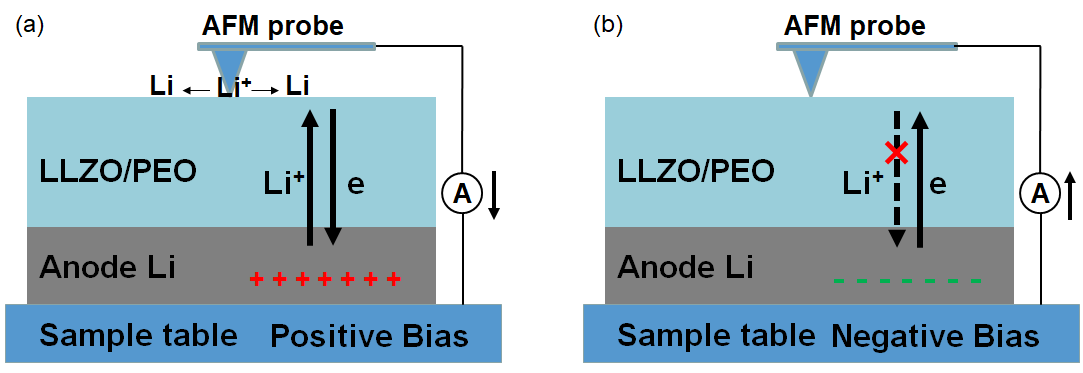Scientists from the Advanced lithium-ion Battery Engineering Laboratory, Ningbo Institute of Materials Technology and Engineering (NIMTE) of the Chinese Academy of Sciences (CAS), revealed the mechanism in of ion and electron migration in composite solid electrolytes (CSEs) through the conductive atomic force microscopy (c-AFM), which facilitated the design of high-performance solid electrolytes. The study was published in Energy Storage Materials.
Compared with the traditional lithium-ion (Li-ion) battery, the solid-state battery with solid materials as electrolyte has higher energy density and safety. As a combination of inorganic solid electrolytes (ISEs) and solid polymer electrolytes (SPEs), CSEs showed excellent contact with electrodes and high ionic conductivity. However, the role of inorganic particles and migration of Li-ions is still controversial.
To address this issue, Dr. SHEN Cai and his colleagues at NIMTE prepared Li7La3Zr2O12-polyethylene oxide (LLZO-PEO) CSEs with different ratios of LLZO, i.e., 0, 50, 75 wt. %. The c-AFM was equipped with a quantitative nano-mechanical measurement module (QNM), which collected the topography and sample current while obtaining mechanical information. By virtue of the c-AFM, the effects of temperature and LLZO content on the migration of ion and electron in CSEs were investigated.
At low temperatures, Li-ions can only migrate along the amorphous PEO regardless of LLZO content. The addition of LLZO lead to the formation of PEO amorphous region at the interface between LLZO and PEO, reducing the crystallinity and glass transition temperature of PEO.
At high temperatures, Li-ions mainly migrated along the amorphous PEO when a small amount (i.e., 0 and 50 wt. %) of LLZO particles was added. With the increase of LLZO content (75 wt. %), LLZO particles formed a continuous ionic conductive network in the PEO matrix, and lithium ions migrated through LLZO particles.
The as-prepared electrolyte showed dominant Li-ion migration, which was three orders of magnitude higher than the electronic current. In addition, the electronic current from PEO is much larger than that of LLZO, which indicated that the addition of LLZO can improve the electronic insulation of CSEs.
Furthermore, due to the high modulus and excellent insulation properties of LLZO, the addition of LLZO into the electrolytes is expected to inhibit the growth of li dendrites in lithium anodes.
This work revealed the influence of inorganic particle content and working temperature on the performance of CSEs, which provided novel insights into the design and development of CSEs for solid-state batteries.
The study was supported by the National key research and development program (No. 2016YFB0100106), National nature science foundation of China (No. U2032126), Ningbo S&T Innovation 2025 Major Special Program (No. 2018B10061) and the Natural Science Foundation of Zhejiang and Taizhou (No. LTY20B030001).

Fig. Schematic illustration of the migration imaging device based on c-AFM (Image by NIMTE)
Contact
SHEN Cai
Ningbo Institute of Materials Technology and Engineering
E-mail: shencai@nimte.ac.cn

